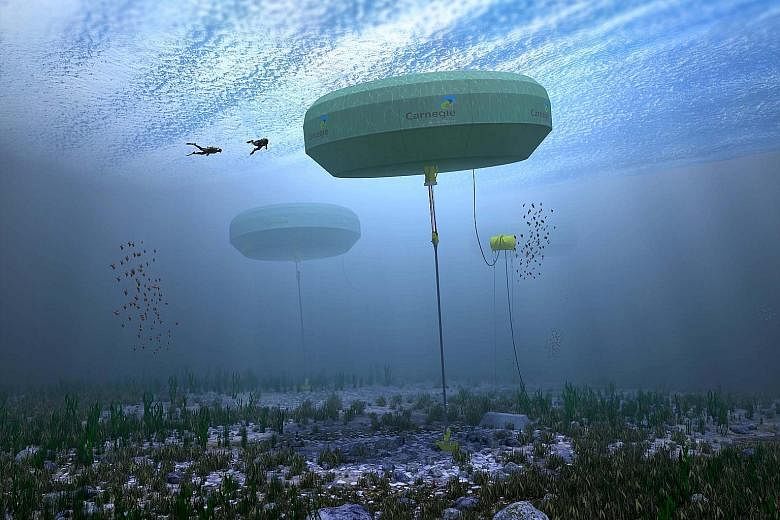Off the west coast of Australia, three large spaceship-style machines were placed underwater in a ground-breaking project that left the ocean floor resembling an alien landing site.
The three buoys were submerged last year and eventually spent more than 12 months underwater as part of an A$30 million (S$32 million) project described as the world's first fully functioning wave energy plant.
The buoys, operated near Perth by Australian company Carnegie Wave Energy, provided power to a nearby naval base on Garden Island and were the first wave energy system to operate through all four seasons for over 14,000 hours in total.
"It is the longest anyone in the world has operated a system for," Carnegie chief executive officer Michael Ottaviano told The Straits Times.
By placing the buoys fully underwater and not above the surface, the Carnegie devices overcame a problem that has long plagued the wave energy sector: The machines end up ruined or damaged by strong waves and ocean storms.
The success of the trial has added to growing hopes that the world's next big source of clean power will come from the ocean.
Along with tidal energy and offshore wind turbines, researchers have focused on wave energy - a power source that has the advantage of being extremely rich in energy and highly predictable.
A researcher at the Australian Maritime College at the University of Tasmania, Dr Jean-Roch Nader, said wave energy is very "dense" in that it can provide large amounts of power across small areas.
In the waters stretching about 3,000km from Perth to Tasmania, Dr Nader said, each metre of coastline could potentially generate enough electricity to permanently power up to 160 houses.
"Wave energy is a lot more predictable than solar and wind," he told The Straits Times.
"You can predict it within three to seven days with a very good accuracy. This is an advantage for buyers, who need to know in advance that they will have a certain amount of energy available."
According to a report in June by accounting and advisory firm Ernst & Young, more than 100 wave pilot projects have been launched around the world in recent years, including plants in Japan, Britain, China, South Korea and Canada. Current output from existing plants is just 4MW but this will increase to 411MW as these proposed projects start operating.
"Waves offer a large source of energy," the report said, adding that "the main challenge today is to drive down the (cost)".
According to estimates by the International Energy Agency, total ocean energy could produce between 20,000 and 80,000 terawatt hours per year, or between 100 per cent and four times the current total global clean energy demand.
Australia's science agency, the CSIRO or Commonwealth Scientific and Industrial Research Organisation, has estimated that wave energy could generate 11 per cent of the country's total power needs by 2050.
Dr Nader said the big hurdle facing the sector is the need to produce commercially viable models that can withstand the heavy impact of waves and severe ocean weather such as offshore cyclones.
"It can have a very big place in the renewable energy market - it is just a matter of installing them and having them survive," he said.
Experts say the most suitable places for wave energy plants are coastal spots which have large swells. Often, these will be in regions at higher latitudes, where there are near-constant winds from the east.
The plants are best suited to coastal cities where they can feed directly into the electricity grid or small remote islands where they can directly supply power to local communities.
With its long coastline and strong swells, Australia is believed to have one of the world's largest sources of wave energy.
Several firms and universities in Australia have been researching and trialling wave energy systems.
The federal government has provided more than A$40 million worth of grants to ocean energy projects in the past three years to promote renewable energy, though Canberra controversially cut funding for these efforts earlier this year.
Analysts say these subsidies have proven vital as the biggest challenge to producing commercially suitable wave energy is the high cost.
Carnegie says it plans to reduce its cost of providing energy by 80 per cent over the next five to 10 years.
The firm removed its three buoys near Perth earlier this year and will replace them next year with one or two new larger models which are 20m in diameter and would, if successful, be commercially viable.
"At the moment, we are expensive because we are brand new," Mr Ottaviano said. "Like every power technology, the way to get cheap is to go big quickly."

